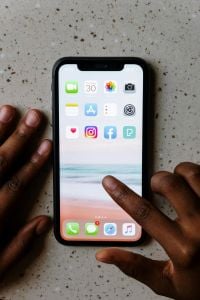
Let’s face it, one of the first things we look at when checking out a new phone is the screen. Whether you’re catching up on your favorite drama, scrolling Insta while having teh tarik, or grinding through Mobile Legends with your friends, the display plays a huge role in your everyday experience.
In 2025, there’s one tech that’s stealing the spotlight in Malaysia’s smartphone scene: AMOLED screen. But what’s so special about it? And why are so many phone users making sure their next phone comes with an AMOLED display?
Don’t worry, our article will tell you. Whether you're a casual user or a hardcore gamer, here’s why AMOLED might just be the upgrade you didn’t know you needed.

Editor
Mae An NG chevron_right
Table of Contents
What is AMOLED Screen?
You’ve probably seen the term “AMOLED” thrown around when shopping for a new smartphone, but what does it actually mean?
AMOLED stands for Active Matrix Organic Light Emitting Diode. Sounds a bit high-tech, right? But don’t worry – it’s simpler than it sounds. An AMOLED display lights up each pixel individually using organic compounds. Unlike traditional LCD screens that need a backlight to shine through, AMOLED screens create their own light, pixel by pixel. This gives you brighter visuals, deeper blacks, and better energy efficiency. No wonder most flagship smartphones in 2025 are rocking AMOLED panels!
Why AMOLED Matters for Smartphones
Smartphone screens today need to do more than just look good. Malaysians use their phones for everything – from scrolling TikTok to catching the latest Netflix drama or playing mobile games. Here’s why AMOLED screens are a game-changer:
Vibrant Colours & True Blacks
Each pixel can switch off completely, so you get pitch-black blacks and ultra-rich colours. Watching YouTube or Disney+ Hotstar in HD? It’s going to look stunning.
Better Battery Life
Dark Mode lovers, rejoice! AMOLED screens use less power when displaying dark colours, which helps your phone battery last longer – perfect for our all-day usage in Malaysia’s fast-paced lifestyle.
Slimmer & Sleeker Designs
Because they don’t need a backlight, AMOLED panels can be super thin. That means you get slimmer phones, stylish curves, or even foldable models – all while looking modern and premium.
Smoother Scrolling & Gaming
With support for high refresh rates (think 90Hz, 120Hz, or more), AMOLED displays make scrolling buttery smooth and games ultra-responsive – whether you're crushing it in Mobile Legends or just browsing Shopee.
How It Works (in a Nutshell)
Each pixel on an AMOLED screen is made of organic material that lights up when an electric current passes through. Thanks to the “active matrix” tech, the screen controls each pixel individually, turning them on and off in an instant. Compared to older LCDs that rely on a backlight and liquid crystals, AMOLED gives you brighter images, richer contrast, and better energy efficiency.
AMOLED Screen vs Other Display Technologies
When choosing a smartphone, display technology is key. Let’s compare AMOLED screens with other popular types:
|
Display Technology |
Description |
Key Features |
Common Brands / Models |
Advantages |
Drawbacks |
|
AMOLED |
Active Matrix Organic Light Emitting Diode. Each pixel lights up individually. |
Deep blacks, vibrant colors, energy efficient |
Most flagship Android phones |
True blacks, thin & flexible, good contrast |
More expensive than LCD |
|
Super AMOLED |
Samsung’s enhanced AMOLED with an integrated touch layer |
Better sunlight visibility, more responsive touch |
Samsung Galaxy A and S series |
Improved brightness & touch response |
Slightly more costly to produce |
|
OLED |
Organic Light Emitting Diode, pixels self-illuminate, but may use a passive matrix |
Great contrast and colors, but slower refresh |
Older flagship phones, Apple iPhones (older) |
Vivid colors, energy efficient |
Not as bright or sharp as AMOLED |
|
Super Retina XDR |
Apple’s advanced OLED (AMOLED-based) technology |
High brightness, true color accuracy, ProMotion (120Hz) |
iPhone 14 Pro, iPhone 15 Pro series |
Industry-leading color accuracy & brightness |
Limited to Apple devices |
|
Fluid AMOLED |
OnePlus’s marketing term for AMOLED with a 90- 120Hz refresh rate and smooth display |
Smooth animations, high refresh rate |
OnePlus 8T, OnePlus 12 series |
Very smooth visuals, vibrant colors |
Mostly for OnePlus phones |
|
Dynamic AMOLED 2X |
Samsung’s latest AMOLED with HDR10+, adaptive refresh rate up to 120Hz |
Extreme brightness, HDR10+, adaptive refresh |
Samsung Galaxy S20 Ultra, S24 Ultra |
Best brightness, adaptive refresh, and HDR support |
Premium price tag |
Key Features of AMOLED Screens in Latest Smartphones

High Refresh Rates: Many AMOLED smartphones now support 90Hz, 120Hz, or even adaptive refresh rates up to 144Hz for super-smooth visuals.

HDR10+ and Dolby Vision Support: For richer colors and better dynamic range, making movies and games look amazing.

High Brightness Levels: AMOLED panels can reach over 1000 nits brightness, which helps in direct sunlight viewing.

Eye Comfort Modes: Many AMOLED screens feature blue light filters and adaptive brightness to reduce eye strain.

Flexible and Foldable Displays: AMOLED enables innovative designs and curved edge screens.

In-Display Fingerprint Sensors: AMOLED screens support optical fingerprint sensors embedded directly beneath the display for faster unlocking.
Final Thoughts
If you’ve been eyeing a new phone lately, the AMOLED screen is now the gold standard for both flagship and mid-range smartphones in Malaysia, and it’s changing the game in 2025.
So, what’s the hype all about?
AMOLED screens offer vibrant colors, true deep blacks, and ultra-smooth visuals that make everything from Netflix binges to TikTok scrolls look and feel way better. But it’s not just about looking good. AMOLED screens are more energy-efficient, giving you better battery life, perfect for our always-on lifestyle. Plus, they’re easier on your eyes, especially if you’re glued to your phone all day (no judgment—we get it!).
Bottom line: If you’re getting a new smartphone in Malaysia this year, make sure it comes with an AMOLED screen. Once you’ve experienced the difference, there’s no going back.
